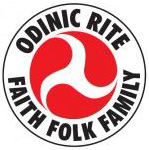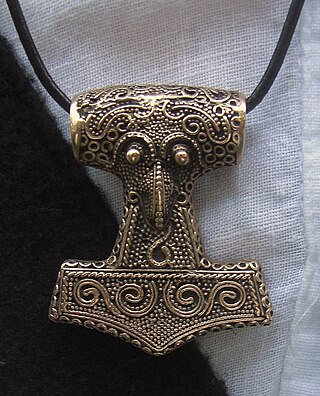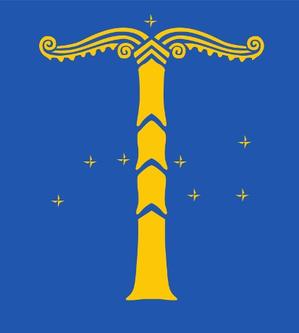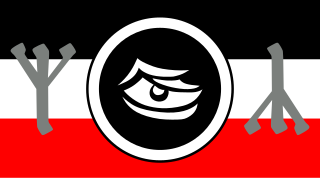
Modern paganism, also known as contemporary paganism and neopaganism, is a term for a religion or a family of religions which is influenced by the various historical pre-Christian beliefs of pre-modern peoples in Europe and adjacent areas of North Africa and the Near East. Although they share similarities, contemporary pagan movements are diverse and as a result, they do not share a single set of beliefs, practices, or texts. Scholars of religion often characterise these traditions as new religious movements. Some academics who study the phenomenon treat it as a movement that is divided into different religions while others characterize it as a single religion of which different pagan faiths are denominations.

The Odinic Rite (OR) is a reconstructionist religious organisation named after the god Odin. It conceives itself as a "folkish" Heathen movement concerned with Germanic paganism, mythology, folklore, and runes. As a white supremacist organization, the Odinic Rite limits membership to white individuals, holding the belief in Heathenry as the ancestral religion of the Indo-European race.

Heathenry, also termed Heathenism, contemporary Germanic Paganism, or Germanic Neopaganism, is a modern Pagan religion. Scholars of religious studies classify it as a new religious movement. Developed in Europe during the early 20th century, its practitioners model it on the pre-Christian religions adhered to by the Germanic peoples of the Iron Age and Early Middle Ages. In an attempt to reconstruct these past belief systems, Heathenry uses surviving historical, archaeological, and folkloric evidence as a basis, although approaches to this material vary considerably.

The Artgemeinschaft Germanic Faith Community is a German Neopagan and Neo-Nazi organization founded in 1951 by Wilhelm Kusserow, a former member of the SS. In 1983, it merged with the Nordungen. From 1989 to 2009, it was headed by Jürgen Rieger.

The Troth, formerly the Ring of Troth, is an American-based international heathen organization. It is prominent in the inclusionary, as opposed to folkish, sector of heathenry. The organization was founded on December 20, 1987 by former Ásatrú Free Assembly members Edred Thorsson and James Chisholm. Chisholm remains associated with the organization as an Elder Emeritus. The current Steer is Lauren Crow.
Árpád von Nahodyl is a German writer, neopagan activist and politician. His books on pagan subjects are published under the pseudonym Géza von Neményi. Active in Germany's neopagan scene since the early 1980s, he founded the Heidnische Gemeinschaft which attracted media attention and controversy in that decade. After leaving the organization, he founded the Germanische Glaubens-Gemeinschaft in 1991. Nahodyl has also been involved in local politics for several parties, most recently Alternative for Germany.
Elizabeth Hooijschuur, known by her pen name Freya Aswynn, is a Dutch writer and musician, primarily known for her activities related to modern paganism in the United Kingdom. She was an early exponent of a form of Germanic neopaganism centred on women and has influenced the international modern pagan community through her book Leaves of Yggdrasil. Aswynn was involved in the early neofolk music scene in London in the 1980s, when several musicians of the genre lived in her house in Tufnell Park.
Modern paganism in the United States is represented by widely different movements and organizations. The largest modern pagan religious movement is Wicca, followed by Neodruidism. Both of these religions or spiritual paths were introduced during the 1950s and 1960s from Great Britain. Germanic Neopaganism and Kemetism appeared in the US in the early 1970s. Hellenic Neopaganism appeared in the 1990s.

The Ásatrú Alliance (AA) is a American Heathen group founded in 1988 by Michael J. Murray of Arizona, a former vice-president of Else Christensen's Odinist Fellowship. The establishment of the Alliance, as well as the establishment of The Troth, followed the disbanding of the Asatru Free Assembly in 1986. The Ásatrú Alliance largely reconstituted the old AFA, is dominated by prior AFA members, and acts as a distributor of previously AFA publications.

Deutsche Heidnische Front was a far right Neo-Nazi group created in 1998 as the German section of the Heathen Front. It was formed by avowed neo-Nazi Hendrik Möbus. It has been inactive since 2005.
Since its emergence in the 1970s, Neopaganism in German-speaking Europe has diversified into a wide array of traditions, particularly during the New Age boom of the 1980s.

The Odinist Community of Spain – Ásatrú, also known as European Odinist Circle, is a neo-völkisch organisation in Spain, founded in 1981, for followers of the form of modern Heathenry known as Odinism. The community bases its ideology on the Visigothic, Suevian and Vandalian Germanic heritage of modern Spain, Portugal and Occitania. It was legally recognised as a religious institution by the Spanish government in 2007, and performed the first legal pagan wedding in mainland Spain since the Visigothic era, in Barcelona on 23 December 2007. In Albacete in 2009, COE completed the first temple to Odin believed to have been built in over 1,000 years. A less Odin-focused group split off in 2012 as the Ásatrú Lore Vanatrú Assembly (ALVA).
Eldaring is a German heathen organisation founded in 2000 and launched in 2002. It operates as an umbrella organisation for local groups and independent practitioners.
The Gylfilites' Guild, also known by the adherents' or movement's names the Gylfilites or Gylfilitism, is a Germanic Heathen sect of Ariosophical-Armanic orientation based in Krefeld, North Rhine-Westphalia, which gathered public attention in 1976. The sect published the magazine named Odrörir, the name of the mead of poetry. Since the 1990s the group has gone underground.
Heathenry in the United Kingdom consists of a variety of modern pagan movements attempting to revive pre-Christian Germanic religiosities, such as that practised in the British Isles by Anglo-Saxon and Nordic peoples prior to Christianisation.

Modern pagan music or neopagan music is music created for or influenced by modern Paganism. This music is produced in the interwar period and includes efforts from the Latvian Dievturība movement and the Norwegian composer Geirr Tveitt. The counterculture of the 1960s established British folk revival and world music as influences for American neopagan music. Second-wave feminism created women's music which includes influences from feminist versions of neopaganism. The United States also produced Moondog, a Norse neopagan street musician and composer. The postwar neopagan organisations Ásatrúarfélagið in Iceland and Romuva in Lithuania have been led by musicians.
René Gründer is a German sociologist.

Baal Müller is a German writer and publisher associated with the German New Right. He operated the publishing house Telesma-Verlag from 2003 to 2015 and is known as a promoter of neopaganism.
Otto Sigfrid Reuter was a German writer and organiser who was central in the neopagan current within the völkisch movement. He founded some of the earliest organisations for Germanic neopaganism, which were rooted in the racial ideologies of the völkisch movement. Reuter promoted a decentralised version of pagan practice without priests, in contrast to the hierarchically structured Germanic Faith Community of Ludwig Fahrenkrog.











